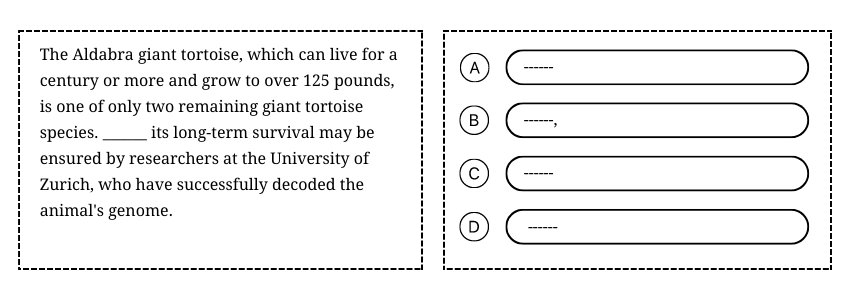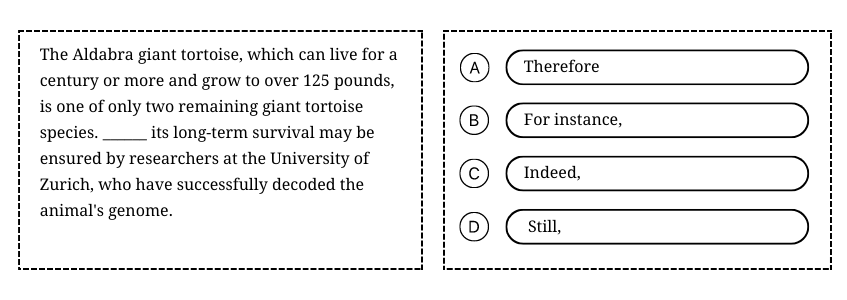Note: The strategies covered in this post can also be applied to the paper-based. Just cover up the transition that is already in the passage; otherwise, the steps are basically the same.
On many versions of the digital SAT, you can expect to encounter about five questions per module testing transitional words and phrases, making this the most common question type on the Writing portion of the test. To ensure you earn what are usually fairly easy points, it is crucial to have an understanding of how to work through these questions before you walk into the exam.
The most important thing is to avoid getting caught up in the details—questions are designed not so much to test particular words as they are to test three main categories of relationships, namely continuation, cause-and-effect, and contrast.
As a result, the fact that therefore might appear in one set of answers, whereas a second might contain thus and a third hence is effectively irrelevant. These words serve the same rhetorical purpose—to indicate a result in a cause-and-effect relationship—and it is the relationship that is really being tested. The words themselves are secondary.
1) Read the question but not the answer choices
A quick glance at the question will tell you that it is testing transitions.
If you happen to notice that the answers consist of, say, However, Moreover, Specifically, and Therefore, that’s obviously a sign as well, but initially you should not worry about the specific words involved. In fact, you should do your best to ignore them because they are more likely to confuse you than to help.
2) Read the passage carefully from beginning to end, actively thinking about what you are reading
Just to be clear here, “from beginning to end” means from the first letter of the first word, all the way through to the final period. The passage will be short, so this is not a major imposition. It is very important that you read the whole thing because if you focus only on the area around the transition, you may miss information necessary to answer the question.
3) Determine the relationship between the statements before and after the transition, without looking at the answers
Again, you have three main options: continue, cause-and-effect, and contrast.
From what I’ve seen of the new exam, I would argue that this step is even more important than before. The College Board appears to have caught on to the ACT’s habit of including multiple transitions in the same category, thereby allowing more than one answer to be eliminated without any knowledge of the actual passage.
Note that there are sub-divisions within some of these categories—for example, moreover and subsequently are both continuers, but they have very different uses. As a result, each of the four answers on the dSAT will generally have a distinct purpose, and there is usually no way to play games with them in order to eliminate two (or more) upfront.
4) Look at the answers, and find the option from the relevant category
In almost all cases, there will be only one choice in the correct category, so that answer will be correct by default.
Although there may be very rare instances in which you are asked to choose between two similar transitions of the same type (e.g., however and nevertheless), these questions are true outliers and should not affect your overall approach.
Let’s look at an example.

We’ll get to the answers in a little while, but for the moment the process is the point.
The passage contains two sentences:
- The first sentence tells us that the Aldabra giant tortoise is at risk of extinction.
- The second sentence tells us that the decoding of its genome will help ensure its survival.
Those are opposite ideas, so we’re looking for a word in the however/nevertheless/despite this category.
Now you get to look at the answers.

Unfortunately, none of the usual, straightforward options are available. You might be able to work by process of elimination, recognizing that (A)-(C) are not contradictors. But if you don’t know that still at the beginning of a sentence can act as a contradictor (meaning “despite this” or “at the same time, however,”), you might get cold feet about actually picking (D).
If you wouldn’t ever do that, great. But as a tutor, I saw this all the time: students would carefully eliminate answers that did not fit, but when they were confused by the last option remaining, they balked and went for an answer that they had conclusively eliminated, just because they knew what it meant. (Remember: whether you understand an answer choice is unrelated to whether it is correct.)
By the way, I made the answer still rather than something more obvious because the dSAT seems to have a bit of a thing for this word—presumably because fewer test-takers know that it can be used the way it’s used here.
This is where the whole thinking in categories bit comes into play. If you need to learn new transitional words or phrases while studying for the test, don’t worry about the nuances of their meanings. Instead, worry about what categories they fall into. (And tutors, if you have limited time with a student who is scoring anywhere below 790 in Reading/Writing, please, please do not waste it discussing minutiae such as nonetheless vs. nevertheless, which will never, ever be tested.)
To draw a STEM analogy, you essentially need to think of transitions as points in a data set that can be swapped with other, equivalent points without affecting an overall result. This time it’s still, next time it might be however. Doesn’t matter. If you know what belongs in what category, you’ll probably be good.

very important thanks for the material